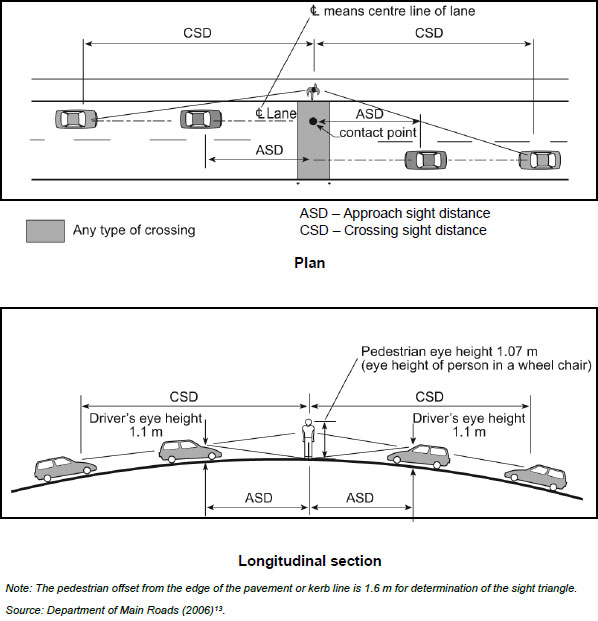Pedestrian crossing facilities should be located and designed such that there is a clear view between approaching drivers and pedestrians on the crossing or waiting to cross the roadway.
The longer the distance to cross, the less likely I will enjoy that part of my walk. I have to keep looking over my shoulder to check no more traffic is coming, it is very stressful. |
Guidance on sight distance at crossings for people walking is provided in various sections of the Austroads Guide to Road Design Part 4A: Unsignalised and signalised intersections [1] and is provided below for ease of reference.
There are two key sight distance requirements at pedestrian crossing facilities:
CSD should be provided at crossings, including:
CSD is desirable at crossings controlled by signals in case of signal failure.
The figures below illustrate the sight distance requirements at crossings.

Sight distance requirements at pedestrian crossings.[2]
Crossing sight distance (CSD) should be provided between approaching vehicles (1.1m eye height) and a pedestrian waiting to cross the road (waiting 1.6m from the pavement edge or kerb line). The pedestrian eye height should be taken as 1.07m which accounts for a child or a person using a mobility device. CSD allows sufficient time for the pedestrian to cross the road, clear of any approaching traffic.
CSD is calculated from the critical safe gap in the traffic stream and the speed of approaching traffic using this equation:

Where:
Notes:
It is important that line of sight for CSD is not impeded by objects such as parked vehicles and street furniture (although minor obstructions such as poles and tree trunks less than 200mm diameter may be ignored). Parked vehicles can cause visual obstructions, especially for children, and people using mobility devices. This may require restricting parking for some distance on each side of the crossing to ensure parked vehicles will not obscure the required sight lines. Where on-street parking needs to be maintained, kerb extensions at the crossing should be provided to improve the visibility of pedestrians.
Approach sight distances should be measured from the driver eye height (1.1m) to ground level (0m), which ensures that a driver is able to see any pavement markings and other cues at a crossing, and therefore be alerted to take the appropriate action if a pedestrian steps onto the crossing.
Approach sight distance (ASD) is calculated by:

Where:
Note: Austroads Part 4A provides correction factors to account for road gradient if necessary.
Values of ASD based on the above equation and for different vehicle speeds and no gradient are listed in the table below.
Table: Minimum approach sight distances
|
Approach vehicle speed (km/h) |
ASD (m) |
|
10 |
5 |
|
20 |
13 |
|
30 |
22 |
|
40 |
34 |
|
50 |
48 |
|
60 |
64 |
|
70 |
83 |
|
80 |
103 |
Note in rural locations driver reaction times may be slower. The Austroads Guide to Road Design Part 4A includes approach sight distances assuming slower reaction times which may be more applicable in these instances.
The approach sight distances listed in the table above presume emergency braking and adequate skid resistance. It is important to assess the skid resistance of the roadway on the immediate approaches to a pedestrian crossing point. Treatment is justified if the skid resistance (sideways force coefficient) is less than 0.55.